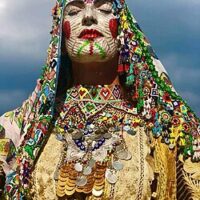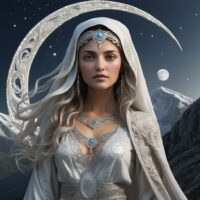Hana : The Moon Goddess
Listen
At a glance
| Description | |
|---|---|
| Origin | European Mythology |
| Classification | Gods |
| Family Members | Dielli (Brother/Husband) |
| Region | Albania |
| Associated With | Moon |
Hana
Introduction
In the mythology of Albania, Hana—also known as Hëna or Hanë—emerges as the celestial embodiment of the Moon. More than just a natural phenomenon, she represents time, fertility, and the balance of cosmic forces. Albanian folklore often describes the Sun and Moon as divine counterparts, with Hana taking on the role of a maternal figure who influences both the natural world and the spiritual lives of people. Her presence is felt not only in myths and legends but also in rituals, seasonal celebrations, and oral traditions that have been passed down for centuries. The reverence for Hana reflects the ancient worldview of the Albanians, who saw the heavens as living, breathing powers guiding their existence.
Physical Traits
Although Hana is not given specific bodily features in the myths, her image is symbolically portrayed with remarkable richness. She is imagined as a luminous figure radiating silver light, embodying both beauty and mystery. Her essence is tied to the cycles of the Moon, which mirror human life—birth, growth, decline, and renewal. Albanian folk traditions preserve this symbolism in visual forms. Crescent moons appear in embroidery, on women’s headscarves, and in traditional jewelry, suggesting Hana’s protective presence over families and communities. In the northern tribes, lunar and solar motifs were often tattooed on women’s hands and faces, believed to grant blessings and ward off evil. These artistic representations make her less of a distant celestial body and more of an intimate force, always watching and guiding.
Family
Hana’s role within the mythological family of celestial beings reveals her importance in the Albanian worldview. In some traditions, she is paired with Dielli, the Sun, forming a divine union that reflects the eternal partnership of male and female principles. Their relationship explains the natural rhythm of day and night, planting and harvest, birth and rest. In other versions of the myth, Hana and Dielli are described as siblings, their coexistence representing complementary forces rather than opposites. From their bond, tales speak of powerful offspring, such as the heroic Daughter of the Moon and the Sun, who wields the powers of light to battle darkness and monstrous beings like the kulshedra, a many-headed serpent that threatens life. Whether as wife or sister, Hana’s kinship with the Sun embodies the interconnectedness of the cosmos in Albanian myth, weaving natural cycles into human storytelling.
Other names
The goddess of the Moon is known by different names depending on dialect and era. In standard Albanian, she is called Hëna, while the Gheg dialect of northern Albania prefers Hana or Hanë. Historical records reveal that early Albanian texts used Hana/Hanë as a divine name, equating her with the Roman goddess Diana, who also governed the Moon, hunting, and feminine power. This syncretism shows how Albanian traditions absorbed and transformed influences from neighboring cultures while retaining their own uniqueness. Even today, the Albanian language preserves her legacy: Monday is called e hënë, directly connected to Hana, echoing the Latin dies Lunae. Her name continues to resonate across cultures, too, since “Hana” carries meaning in languages such as Hebrew, Arabic, Japanese, and Hawaiian, although with different associations.
Powers and Abilities
Hana’s powers, though not always spelled out in ancient texts, are evident through her association with the Moon’s cycles. She governs time by marking the rhythm of agricultural seasons, guiding farmers in planting and harvesting. Fertility, both of the land and of women, is closely tied to her phases, with the waxing Moon seen as a sign of abundance and the waning Moon as a time of rest or reflection. Hana also symbolizes protection, particularly for women and children, with her image often invoked in blessings, charms, and lullabies. Her role extends into the mythic struggle between light and darkness. Legends tell of her light empowering heroes or her daughter in the battle against destructive creatures, showing Hana not just as a passive celestial figure but as an active source of strength in Albania’s mythological landscape.
Modern Day Influence
Despite Albania’s shift to Christianity and later to Islam, Hana remains a cultural constant, deeply embedded in the national psyche. Her influence survives in everyday language, artistic traditions, and symbolic motifs. Folk embroidery, silver jewelry, and carved household objects continue to carry lunar symbols, celebrating her role in family protection and fertility. Albanian literature also draws inspiration from Hana. Writers of the Renaissance period, such as Jeronim de Rada, integrated lunar symbolism into their works, using Hana as a bridge between myth and national identity. In modern literature and film, characters named Hana appear frequently, carrying echoes of the ancient Moon goddess into contemporary narratives. For example, in Elvira Dones’s novel, Hana is a central character whose name evokes resilience and transformation, while in the film Nëntor i ftohtë, Hana is portrayed as a nurturing presence within a family.
In academic circles, Hana continues to attract attention. Scholars like Robert Elsie have dedicated works to documenting Albanian religion and mythology, ensuring that Hana’s story is preserved for future generations. Her name and symbolism also reappear in discussions of Albanian national identity, particularly in studies of foundational myths that shape cultural pride. Beyond Albania, Hana is reinterpreted by artists and feminists who see in her the archetype of the enduring feminine force—cyclical, resilient, and nurturing. Digital platforms and cultural revival projects across the Balkans are bringing her myth back into the public eye, making Hana not just a figure of the past but also a symbol of continuity and transformation in the modern era.
Related Images
Source
Elsie, R. (2001). A dictionary of Albanian religion, mythology, and folk culture. Hurst & Company. Retrieved from https://archive.org/details/dictionaryofalba0000elsi
Wikipedia contributors. (n.d.). Hëna (Albanian paganism). Wikipedia. Retrieved September 2, 2025, from https://en.wikipedia.org/wiki/H%C3%ABna_(Albanian_paganism)
Mythosphere. (n.d.). Albanian Mythology. Folklore Earth. Retrieved September 2, 2025, from https://www.folklore.earth/culture/albanian/
R. Elsie. (2002). A Dictionary of Albanian Religion, Mythology, and Folk Culture by Robert s> Elsie (review). In Slavonic and East European Review. https://www.semanticscholar.org/paper/31bfd80ed9311a8c83326ec60efb2d4a22efb479
Koliqi, S. (2022, January 1). Albanian Myths and Custom Law in Literature.
Frequently Asked Questions
What is lorem Ipsum?
I am text block. Click edit button to change this text. Lorem ipsum dolor sit amet, consectetur adipiscing elit. Ut elit tellus, luctus nec ullamcorper mattis, pulvinar dapibus leo.
What is lorem Ipsum?
I am text block. Click edit button to change this text. Lorem ipsum dolor sit amet, consectetur adipiscing elit. Ut elit tellus, luctus nec ullamcorper mattis, pulvinar dapibus leo.
What is lorem Ipsum?
I am text block. Click edit button to change this text. Lorem ipsum dolor sit amet, consectetur adipiscing elit. Ut elit tellus, luctus nec ullamcorper mattis, pulvinar dapibus leo.
What is lorem Ipsum?
I am text block. Click edit button to change this text. Lorem ipsum dolor sit amet, consectetur adipiscing elit. Ut elit tellus, luctus nec ullamcorper mattis, pulvinar dapibus leo.
What is lorem Ipsum?
I am text block. Click edit button to change this text. Lorem ipsum dolor sit amet, consectetur adipiscing elit. Ut elit tellus, luctus nec ullamcorper mattis, pulvinar dapibus leo.







